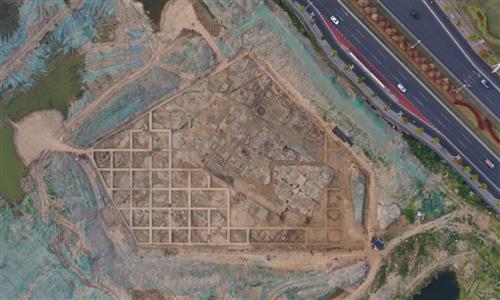ARTS / CULTURE & LEISURE
Ancient Liulihe inscriptions confirm 3,000-year urban legacy of Beijing

The Liulihe relic site in Beijing's Fangshan district Photo: Li Hao/GT
Ancient inscriptions unearthed at the Liulihe relic site in Beijing's Fangshan district have proved the capital city's urban history spanning over 3 millennia.The Liulihe site, which is recently named among China's top 10 archaeological discoveries of 2024, is the largest known Western Zhou Dynasty (1046BC-771BC) ruins site south of the Yanshan Mountains, according to a document that Beijing Municipal Cultural Heritage Bureau sent to the Global Times on Tuesday.
The site has yielded remarkable evidence from the dynasty, including five ritual bronze vessels inscribed with four characters "Tai Bao Yong Yan," which means great minister Shao Gong (the Lord of Shao) built capital of the Yan state of the Western Zhou Dynasty.
Archaeologists said this confirms historical accounts that the city was built under the orders of a legendary Zhou Dynasty statesman to secure the northern Yan territory.
"These inscriptions provide the earliest physical evidence of Beijing's 3,000-year urban lineage," Wang Jing, lead archaeologist at the site from the Beijing Municipal Cultural Heritage Bureau, told the Global Times. "They also fill a critical gap in records of Bronze Age urban planning and highlight Yan's political significance."
Since 2019, archaeologists have conducted large-scale excavations across 800,000 square meters, discovering 930 relics from the Western Zhou Dynasty, including rammed-earth foundations, ash pits and tombs, according to the document.
Excavations across 3,400 square meters revealed outer city walls, moats, rammed-earth foundation, 52 tombs, and remnants of small dwellings.
Adjacent to the outer city moat's northern section, remnants of a 6- to 9-meter-wide outer wall were discovered, bearing traces of rammed-earth construction. Carbon-14 dating and artifact analysis indicate the moat was functional during the early Western Zhou period before falling into disuse.
The site of large-scale rammed-earth foundation has also yielded inscribed oracle bones, primitive porcelain fragments and advanced architectural materials such as tile nails.




